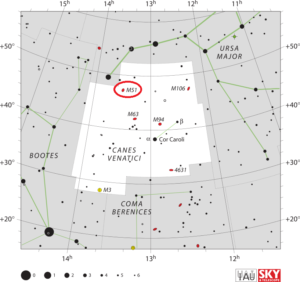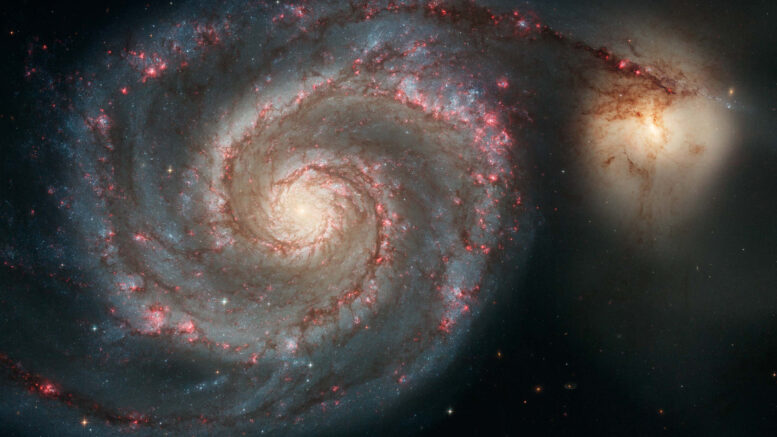The Whirlpool Galaxy is an interacting grand-design spiral galaxy with a Seyfert 2 active galactic nucleus. It lies in the constellation Canes Venatici, and was the first galaxy to be classified as a spiral galaxy.
In good conditions, the Whirlpool Galaxy can be seen in binoculars. It is quite bright and appears face-on, which makes it a popular target among amateur astronomers and astrophotographers. M51 is also the brightest example of an interacting spiral galaxy in the sky.
| Description | |
| Visible From Pacific Northwest | January To June |
| Best Time To Observe | March, April, and May |
| Minimum Size Of Viewing Device | Binoculars In Great Condition |
| Object Type | grand-design spiral galaxy |
| Designations | Messier 51, M51, M51a, NGC 5194, Whirlpool Galaxy, Rosse’s Galaxy, Question Mark Galaxy, PGC 47404, UGC 8493, Arp 85, GC 3572, VV 001a, VV 403, BD+47 2063, IRAS 13277+4727, 1RXS J132953.8+471143, TC 827 |
| Right Ascension | 13h 29m 52.7s |
| Declination | +47°11’43” |
| Constellation | Canes Venatici |
| Number Of Stars | 100 Billion |
| Apparent magnitude | +8.4 |
| Apparent dimensions | +47°11’43” |
| Object Radius | 60,000 light years |
| Distance From Earth | 23 million light years |
History
The Whirlpool Galaxy is one of Charles Messier’s original discoveries. Messier first observed the object on October 13, 1773.
NGC 5195 was discovered by Messier’s friend and colleague Pierre Méchain on March 20, 1781. In his catalogue of 1781, Messier did not make it entirely clear if the object that he was referring to as M51 was just the larger galaxy or the interacting pair. As a result, the Whirlpool Galaxy (NGC 5194) is sometimes referred to as Messier 51a and the smaller NGC 5195 as Messier 51b.
William Herschel catalogued the object as H I.186 on May 12, 1787, with the following note: “Considerably bright. Pretty Large. Round or little elongated. Very gradually brighter toward the middle. 3′ north preceding [NW] of the 51st of the Connoissance des Temps [M51].”
John Herschel catalogued M51 as h 1622 in April 1830, noting a “very bright round nucleus surrounded at a distance by a nebulous ring.” He later added the object to the General Catalogue as GC 3574.
Locating M51 In The Sky
Messier 51 is one of the easiest Messier objects to find, as it lies in the vicinity of the Big Dipper asterism. The galaxy is positioned only 3.5 degrees southwest of Alkaid, Eta Ursae Majoris, the star that marks the end of the Dipper’s handle, or the tip of the Great Bear‘s tail.
An imaginary line drawn from Alkaid in the direction of Cor Caroli, the brightest star in Canes Venatici, leads directly to M51.

Viewing M51
Messier 51 appears as a patch of light in 10×50 binoculars, while small telescopes show a more diffuse patch of light with a bright central region. The galaxy’s bright core appears more defined in 8-inch instruments, which also reveal the galaxy’s large halo and a hint of the dark dust lanes and spiral arms. M51’s smaller companion galaxy, NGC 5195, is also visible, but the bridge connecting the two can only be detected in larger instruments.
12-inch and larger telescopes reveal a number of spiral bands and vast H II regions, as well as the band of light that connects the Whirlpool Galaxy to its smaller neighbour. The best time of year to observe M51 is in the months of March, April and May.
Photographing M51
Messier 51 is a northern hemisphere deep-sky object that is bright enough to observe in amateur telescopes. It is a popular choice for amateur astrophotographers during galaxy season. The reason why this galaxy is famous is because you can see the small one getting slowly eaten by the other. The Whirlpool Galaxy is an extremely satisfying astrophotography target due to its high surface brightness and impressively detailed spiral arm structure.
It is possible for an astrophotographer of any skill level to photograph The Whirlpool Galaxy because all one needs is a DSLR and a larger telescope with autoguiding. Once polar aligned, one can spend around 2 to 3 hours of time getting single exposures as long as 6 minutes. With longer exposure photography, it does expose a subtle glow around the galaxy.
https://www.galactic-hunter.com/post/m51-the-whirlpool-galaxy
Sources And Further Reading
Descriptions of all of Messier Objects can be found here.
https://www.messier.seds.org/m/m051.html
https://freestarcharts.com/messier-51
https://www.nasa.gov/feature/goddard/2017/messier-51-the-whirlpool-galaxy

Be the first to comment on "Messier 51 The Whirlpool Galaxy"